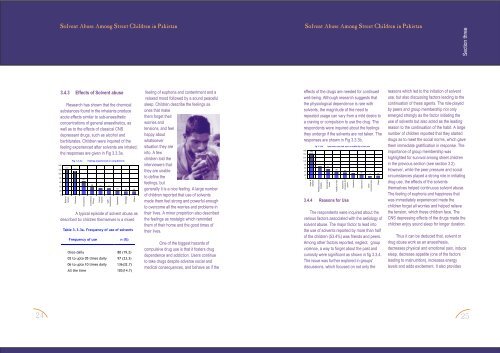solvent-abuse-pakistan
solvent-abuse-pakistan
solvent-abuse-pakistan
You also want an ePaper? Increase the reach of your titles
YUMPU automatically turns print PDFs into web optimized ePapers that Google loves.
3.4.3 Effects of Solvent <strong>abuse</strong><br />
Research has shown that the chemical<br />
substances found in the inhalants produce<br />
acute effects similar to sub-anaesthetic<br />
concentrations of general anaesthetics, as<br />
well as to the effects of classical CNS<br />
depressant drugs, such as alcohol and<br />
barbiturates. Children were inquired of the<br />
feeling experienced after <strong>solvent</strong>s are inhaled;<br />
the responses are given in Fig 3.3.3a.<br />
140<br />
120<br />
100<br />
80<br />
60<br />
40<br />
20<br />
0<br />
117<br />
Relief of<br />
tension<br />
Fig. 3.3.3a<br />
111<br />
Euphoria<br />
65<br />
Drowsiness<br />
Feelings experienced on using Solvents<br />
36 33 31<br />
Confident &<br />
Strong<br />
Cannot<br />
express<br />
Light<br />
headedness<br />
19 16 16<br />
A typical episode of <strong>solvent</strong> <strong>abuse</strong> as<br />
described by children themselves is a mixed<br />
Table 3. 3.3a. Frequency of use of <strong>solvent</strong>s<br />
Frequency of use n (%)<br />
Once daily<br />
02 to upto 05 times daily<br />
06 to upto 10 times daily<br />
All the time<br />
Agression<br />
Section three<br />
Nostalgia<br />
80 (19.2)<br />
97 (23.3)<br />
136(32.7)<br />
103(14.7)<br />
Others<br />
feeling of euphoria and contentment and a<br />
relaxed mood followed by a sound peaceful<br />
sleep. Children describe the feelings as<br />
ones that make<br />
them forget their<br />
worries and<br />
tensions, and feel<br />
happy about<br />
whatsoever<br />
situation they are<br />
into. A few<br />
children told the<br />
interviewers that<br />
they are unable<br />
to define the<br />
feelings, but<br />
generally it is a nice feeling. A large number<br />
of children reported that use of <strong>solvent</strong>s<br />
made them feel strong and powerful enough<br />
to overcome all the worries and problems in<br />
their lives. A minor proportion also described<br />
the feelings as nostalgic which reminded<br />
them of their home and the good times of<br />
their lives.<br />
One of the biggest hazards of<br />
compulsive drug use is that it fosters drug<br />
dependence and addiction. Users continue<br />
to take drugs despite adverse social and<br />
medical consequences, and behave as if the<br />
effects of the drugs are needed for continued<br />
well-being. Although research suggests that<br />
the physiological dependence is rare with<br />
<strong>solvent</strong>s, the magnitude of the need to<br />
repeated usage can vary from a mild desire to<br />
a craving or compulsion to use the drug. The<br />
respondents were inquired about the feelings<br />
they undergo if the <strong>solvent</strong>s are not taken. The<br />
responses are shown in Fig 3.3.3b.<br />
160<br />
140<br />
120<br />
100<br />
80<br />
60<br />
40<br />
20<br />
0<br />
142<br />
Anger &<br />
Agitation<br />
Fig. 3.3.3b<br />
69<br />
Restlessness &<br />
Irritability<br />
Symp toms r epo rted upo n un availib ility o f solv ents<br />
3.4.4 Reasons for Use<br />
54<br />
Generalized<br />
Aches<br />
38<br />
Inability to work<br />
33 30<br />
Abdominal<br />
cramps & GIT<br />
upsets<br />
The respondents were inquired about the<br />
various factors associated with the aetiology of<br />
<strong>solvent</strong> <strong>abuse</strong>. The major factor to lead into<br />
the use of <strong>solvent</strong>s reported by more than half<br />
of the children (53.4%) was friends and peers.<br />
Among other factors reported, neglect, group<br />
violence, a way to forget about the past and<br />
curiosity were significant as shown in fig 3.3.4.<br />
The issue was further explored in groups'<br />
discussions, which focused on not only the<br />
Headache<br />
22<br />
Depression<br />
14 15<br />
Semiconsciousness<br />
Others<br />
reasons which led to the initiation of <strong>solvent</strong><br />
use, but also discussing factors leading to the<br />
continuation of these agents. The role-played<br />
by peers and group membership not only<br />
emerged strongly as the factor initiating the<br />
use of <strong>solvent</strong>s but also acted as the leading<br />
reason to the continuation of the habit. A large<br />
number of children reported that they started<br />
drugs as to meet the social norms, which gave<br />
them immediate gratification in response. The<br />
importance of group membership was<br />
highlighted for survival among street children<br />
in the previous section (see section 3.2).<br />
However, while the peer pressure and social<br />
circumstances played a strong role in initiating<br />
drug use, the effects of the <strong>solvent</strong>s<br />
themselves helped continuous <strong>solvent</strong> <strong>abuse</strong>.<br />
The feeling of euphoria and happiness that<br />
was immediately experienced made the<br />
children forget all worries and helped relieve<br />
the tension, which these children face. The<br />
CNS depressing effects of the drugs made the<br />
children enjoy sound sleep for longer duration.<br />
Thus it can be deduced that, <strong>solvent</strong> or<br />
drug <strong>abuse</strong> work as an anaesthesia,<br />
decreases physical and emotional pain, induce<br />
sleep, decrease appetite (one of the factors<br />
leading to malnutrition), increases energy<br />
levels and adds excitement. It also provides<br />
24<br />
25


